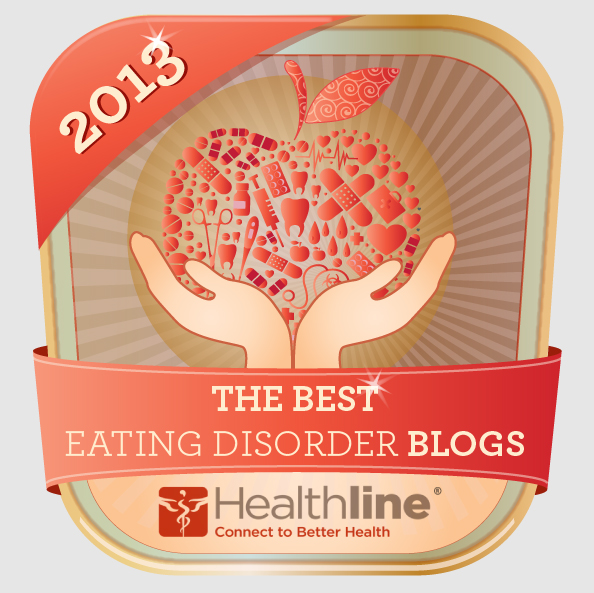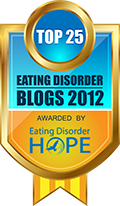Eating Disorders News And Views: February 23, 2013
Eating Disorder Survivors Share Tales of Recovery
DesMoinesRegister.com
Michaela Kitt’s family first noticed she was unusually thin when she was 8 years old. By the time she was 15, she’d been hospitalized twice for anorexia nervosa, a condition where one restricts food. Erin Moore was a senior in high school when she began binging and purging to cope with family difficulties — classic signs of bulimia. Both girls recovered from their eating disorders by seeking help early, with the help of family. They’re sharing their stories as part of a program Feb. 27 hosted by outpatient mental health counselor Lynne Vestal during National Eating Disorders Awareness Week.
Read Survivors in full.
Are Personality Disorders Overdiagnosed in EDs?
Edbites.com
Lots of other mental health conditions commonly co-occur with eating disorders. I’ve blogged before about the links between OCD and EDs, and I’ve tangentially talked about links to depression and other anxiety disorders. But a paper published this week in the journal Psychopathology (von Lojewski, Fisher, & Abraham, 2013) reminded me that I haven’t yet blogged about the relatively strong and frequent co-occurrence of personality disorders and EDs.
First, some definitions. Quoth Wikipedia on the subject of personality disorders:
These behavioral patterns in personality disorders are typically associated with substantial disturbances in some behavioral tendencies of an individual, usually involving several areas of the personality, and are nearly always associated with considerable personal and social disruption. Additionally, personality disorders are inflexible and pervasive across many situations, due in large part to the fact that such behavior may be ego-syntonic (i.e. the patterns are consistent with the ego integrity of the individual) and are, therefore, perceived to be appropriate by that individual. This behavior can result in maladaptive coping skills, which may lead to personal problems that induce extreme anxiety, distress or depression. The onset of these patterns of behavior can typically be traced back to early adolescence and the beginning of adulthood and, in some instances, childhood.
Read Overdiagnosed in full.
Battling Anorexia and its Stereotypes
northamptonchron.co.uk
“I remember looking outside and seeing that the sun was shining and it was springtime but I realised I wasn’t connecting with the world in any way,” said Georgina Routen, recalling the moment she knew she needed help to fight her anorexia.
“I couldn’t face the thought of getting out of bed, I was completely at the point of exhaustion and I thought, how had I done this to myself? At that point I realised I needed to do something, I wasn’t living, I was dreaming my way through the world. I was disconnected from everyone and everything around me. All I did was think about food and my school work.”
Seeing images of those stricken with an eating disorder always leads to this exact question: how can anyone let this happen to themselves?
Catwalk images of overly skinny models are often cited as a motivation for anorexia, arguably fuelling the typically false stereotype that this life-threatening illness is just a diet which has gone badly wrong.
Read Stereotypes in full.
Understanding the Genetic Basis of Anorexia
CTV Montreal (video report)
Every time she stepped on a scale, every time she looked in a mirror, Jennifer Youssef was horrified by the morbidly obese person she saw.
It didn't matter that this 300 pound person didn't exist -- for her, the image was overwhelming.
"I said I should be perfect. I want to just be perfect," said Youssef. PHOTOS Jennifer Youssef weighed just 95 pounds.
The way toward perfection was to starve herself. But the problem with anorexia is that no matter how thin a person is in reality, the brain sees itself differently.
"It was never good enough, my weight was never low enough. I just wanted to keep losing and losing and losing."
At one point she weighed 95 pounds, but in her brain she was fat and ugly.
"I was not eating. I was exercising. I was abusing laxatives, I was abusing fat burners," said Youssef.
Anorexia Nervosa is not just an eating disorder, but a mental illness that affects tens of thousands of women in Quebec. It's also one of the most deadly mental illnesses, with up to 10 percent of those affected dying of the disorder.
Read Genetic Basis in full.
Anorexia Death Leads Mother to Call for Hospital Reform
guardian.co.uk
Vickie Townsend said that as Laura Willmott approached 18 medical staff stopped telling her of her daughter's progress
The mother of a teenage girl who died from anorexia has called for hospitals to change the way they treat young people as they become adults.
Vickie Townsend's daughter, Laura Willmott, died from complications caused by the eating disorder. Townsend told an inquest that as the former public schoolgirl approached her 18th birthday, medical staff stopped informing her of her daughter's progress.
Avon coroners' court heard that Willmott, first diagnosed with anorexia at 13, succumbed to the condition in December 2011 a week after suffering a cardiac arrest while being treated in hospital.
She had been discharged from child and adolescent mental health services (CAMHS) shortly before turning 18 the previous February because she no longer wanted help and was missing appointments. By 28 October she was in such poor health she was admitted to Frenchay Hospital in Bristol, but was discharged on 8 November with a feeding plan to follow at home, against her mother's wishes.
Read Hospital Reform in full.
New Characteristic of Binge Eating Identified
cbs42.com (video report)
UAB's latest binge eating study involves food concoctions ... which is the strange mixture of completely unlike foods which patients binge on.
The study is making medical news around the country because it may be one of the first times concocting has been specifically investigated.
Like a chemist in a lab preparing drugs, experts say binge eaters are no different. They feel excitement and are anxious leading up to the point where they binge. UAB's new characteristics of binge eating identified odd concoctions ... like mashed potates and oreo cookies with pickles, or frozen vegetables mixed with mayonnaise and chips with lemon, pork rinds and salt.
Beth McMurray is the Clinical Director at "A Center for Eating Disorders". She is also a recovering binge eater.
McMurray says what UAB's study has " revealed" has the potential to help caregivers and patients in a tremendous new way. It found that 41 percent of those who concocted said the behavior was due to a craving ... only nine percent reporter hunger as a motive.
Read New Characteristic in full.
Operation Beautiful holds panel on Eating Disorders and Recovery
breezejmu.org
Liz Klemt, a senior health sciences major, thought she knew everything about nutrition until her counselor told her she wouldn’t die if she ate a cheesesteak.
Starting November 2011, she had a binge eating and excessive exercising disorder, but never purged.
On Tuesday night, Operation Beautiful, a club that seeks to promote positive body image and raise eating disorder awareness, held a panel discussion on the prevention, education and treatment of eating disorders in honor of eating disorder awareness month.
Klemt said she used to lie to her roommate about how often she worked out.
“I would tell her I only ran a little in the morning, but it was actually five miles,” Klemt said. “At night, I would sometimes run eight miles.”
Klemt hasn’t binged since November of 2012. She hopes to inspire others through her story.
“I realized that calories are fuel and your body needs them,” Klemt said. “It’s not necessary to constantly read food labels.”
Read Operation Beautiful Panel in full
Eating Disorder Awareness Week
ndsuspectrum.com
The NDSU Counseling Center and several student organizations will shine a spotlight on the importance of positive body image and healthy lifestyle habits during national Eating Disorder Awareness Week Feb. 25 to March 2.
The demands of college life have attributed to nearly 25 percent of college students nationwide suffering from eating disorders, according to the National Institute of Mental Health.
Although eating disorders such as Anorexia Nervosa, Bulimia Nervosa, Binge Eating Disorder and Obesity have much to do with genetic predispositions, the intense external pressures of a college lifestyle can wreak havoc on a person’s mental health, which may lead to an eating disorder. They are the deadliest of all mental health problems, but the key, according to Counseling Center Assistant Director Marlys Borkhuis, is prevention through education and maintaining a positive body image. “It is such a time of growth, being in college,” Borkuis stated.
“It is a time of change for students and part of that is figuring out your balance. People don’t get into an eating disorder purposefully; people fall into it very innocently.”
Read ED Awareness Week in full.
Putting a Stop to Unhealthy Weight-Based Commentary!
uncexchanges.wordpress.com
One of the first things I tell my patients struggling with an eating disorder or body image concerns is that when people say to you, “You look like you’ve gained weight” or “You look so thin”, it is okay and appropriate to say back both politely and firmly, “I feel uncomfortable when you comment on my body and would prefer that we talk about something else.”
We have lost our sense of propriety when it comes to what is and isn’t appropriate to say about other peoples’ bodies. This type of talk begins with the media and trickles down to the family dinner table. The media teach us that there is one clear standard of beauty (i.e., tall, thin, and young) and that until we reach that unrealistic standard, we have a problem that needs to be fixed. Not only are we taught that our bodies are flawed and need to be fixed, we are also taught that our physical “inadequacies” are a result of our own failure or a lack of will power. No wonder we feel inadequate!
One of the ways that media reinforce this idea is by endlessly commenting on bodies, particularly the bodies of public figures who do not fit society’s beauty mold. In the wake of the Grammy awards, we saw numerous media reports commenting on Adele and Kelly Clarkson’s weight.
Read Putting a Stop in full.
Walking Billboards? No Way! Love Your Body
eatingdisorderhope.com
Our body image deeply affects our relationship with our body. Unfortunately, resolving body image problems is one of the most difficult and longstanding challenges for those in eating disorder recovery. Research seems to indicate that there may be a true level of distorted body perception when it comes to individuals with eating disorders, particularly in the case of anorexia. But, there is much hope for developing a more positive body image and an increasingly compassionate and respectful relationship with our body.
Body image and eating disorders are deeply entwined. Likely, the body image was poor long before the eating disorder developed. A poor body image can be triggered by teasing from others growing up...
Read Walking Billboards in full.
What might Family Based Treatment Suggest About Treatment for Adults with Eating Disorders?
eatingdisorderscleveland.org
In the field of eating disorders, multiple studies have shown that Family Based Treatment (FBT) is the most effective method available to achieve successful weight restoration and maintenance after treatment is completed. Unfortunately, specific treatments for adults have not been shown to have the same long term benefits as
FBT. Clearly there are many variables involved in this data, however there are elements to FBT that may point us to a better understanding of what happens for adults.
FBT has 3 distinct phases: refeeding, transition of control from family back to the patient, and addressing normal adolescent issues. All of this happens while the adolescent is in the (hopefully) safe confines of their family. For adults, intensive treatment often stops after refeeding and cessation of behaviors, which would be considered only phase 1 of FBT. It often happens that an adult client...
Read FBT in full.
Subscribe to:
Post Comments (Atom)
























0 comments:
Post a Comment